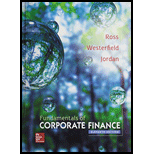
Concept explainers
a)
To determine: Whether the given statement is true or false.
Price index:
The weighted average of a price in relative to the given class of services or goods in the given place and during the given period is a price index.
b)
To determine: Whether the given statement is true or false.
Exchange rate:
The price of a country’s currency that in terms of another nation’s currency is the exchange rate. The rate of exchange can be either floating or fixed. The two components of the exchange rates are the foreign currency and the domestic currency.
c)
To determine: Whether the given statement is true or false.
Inflation:
The general increase in the price level of the goods and services in an economy over a period of time is inflation.
Want to see the full answer?
Check out a sample textbook solution
Chapter 21 Solutions
Fundamentals of Corporate Finance with Connect Access Card
- H3. The Central Bank of the Bahamas pegs the Bahamian Dollar to the United States Dollar at a price of 1 BSD per USD. As an analyst for XYZ Consulting Inc., you have been asked to predict the behavior of key macroeconomic variables in the Bahamas for different policy scenarios. Using all the appropriate diagrams, your analysis must describe the Bahamian money and output markets, as well as the foreign exchange market. To perform this task, you must assume that prices are sticky: fixed in the short-run and flexible in the long-run. The scenarios are: a) A temporary restrictive monetary policy in the Bahamas. b) A temporary restrictive fiscal policy in the Bahamas.arrow_forwardQUESTION 1Everything else equal, the Phillips-curve in a country will shift upwards when the unemployment rate fallsthe central bank cuts interest ratesoil prices risethe government reduces tax rates on labour QUESTION 2Consider a country with a flexible exchange rate. If the central bank of this country raises its interest rate by 0.5%-points, whereas observers had anticipated an increase of only 0.25%-points, one can expect that: Bond prices and stock prices rise, the country’s currency depreciatesBond prices rise, stock prices fall, the country’s currency appreciatesBond prices fall, stock prices rise, the country’s currency depreciatesBond prices and stock prices fall, the country’s currency appreciates QUESTION 3We asked five students to give us three possible sources of an increase of the monetary base in the economy. Only one of the students came up with a completely correct list. This list included: an increase in central bank lending to banks, a purchase of…arrow_forward2.) Pound 0.64/$ in London, 1.04/Euro in New York, and Pound 0.64/Euro in Frankfurt. Depending on this information, how do you think you can make a profit by trading currency in the given monetary centers? calculate your profit by explaining transactionsarrow_forward
- If the U.S. dollar appreciates, an MNC's _____. A. U.S. sales will probably decrease B. exports denominated in U.S. dollars will probably increase C. exports denominated in foreign currencies will probably increase D. interest owed on foreign funds borrowed will probably increasearrow_forwardD3 Suppose the 1-year domestic interest rate is 0.28, keeping in mind that means (100\times×0.28)%. Suppose also that the 1-year expected exchange rate is 59, and the current spot exchange rate is 50, both measured in domestic currency per foreign currency. What is the 1-year foreign interest rate according to uncovered interest parity?arrow_forwardQ1) The equilibrium exchange rate of pounds is USD1.70. At an exchange rate of USD1.72 per pound: * A) U.S. demand for pounds would exceed the supply of pounds for sale and there would be a shortage of pounds in the foreign exchange market. B) U.S. demand for pounds would be less than the supply of pounds for sale and there would be a shortage of pounds in the foreign exchange market. C) U.S. demand for pounds would exceed the supply of pounds for sale and there would be a surplus of pounds in the foreign exchange market. D) U.S. demand for pounds would be less than the supply of pounds for sale and there would be a surplus of pounds in the foreign exchange market.arrow_forward
- 22) The current exchange rate is 0.85 euros per dollar, but you believe the dollar will decline to 0.80 euros per dollar. If a euro-denominated bond is yielding 2%, what return do you expect in U.S. dollars?arrow_forwarde) Suppose that the current spot exchange is: 1 BP (British pound) = $1.21. Use the following interest rates. The interest rate is 8% in the US market (home market). The interest rate is 3% in the UK market (foreign market). iii) If the forward exchange rate is 1 euro = $1.23 (the IRP does not hold), from what market will you have more investment return (%)?arrow_forwardMultinational Finance & Investment Question 2 f) If the spot exchange between Euro and pound is Euro 1.1/Pound, and the UK Guilt returns a 0.5% yield. It is also known that the Euro is expected to depreciate against the pound by 0.5%. What is the yield of a French government bond?arrow_forward
